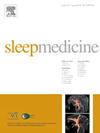Does therapeutic CPAP pressure correlate with OSA severity in children?
IF 3.8
2区 医学
Q1 CLINICAL NEUROLOGY
引用次数: 0
Abstract
Objective/background
Continuous positive airway pressure (CPAP) is widely used to treat severe obstructive sleep apnea (OSA) in children. We observed that non polysomnography (PSG)-titrated CPAP pressures ranged close to 8 cmH2O in children with OSA. The aim of this study was to determine if there was a relationship between OSA severity, the age of the children and CPAP pressure.
Methods
Children with OSA, comprising mainly children with complex OSA, who were started on constant CPAP, with no attended PSG according to our clinical practice, were included. CPAP pressure, baseline polygraphic and anthropometrics data were retrospectively collected.
Results
Mean therapeutic CPAP pressure was 8 ± 1 (range 6–12) cmH2O in 153 children treated with CPAP at a mean age of 3.7 ± 3.4 (0.1–15.9) years. CPAP pressure slightly correlated with age at CPAP initiation (r = 0.226, p = 0.005), baseline mixed and obstructive apnea-hypopnea index (MOAHI; r = 0.185, p = 0.025), oxygen desaturation index (ODI; r = 0.300, p < 0.001), mean (r = −0.230, p = 0.005) and minimal pulse oximetry (SpO2; r = −0.318, p < 0.001). BMI z-score did not correlate with CPAP pressure, apnea-hypopnea index (AHI), MOAHI, nor ODI. CPAP pressure, AHI, MOAHI and ODI did not vary between age categories.
Conclusions
A weak correlation was observed between therapeutic CPAP pressure and MOAHI in our cohort of children, with no correlation with BMI, highlighting the potential role of other factors, such as anatomical features. Future studies should confirm these findings with PSG-titrated CPAP pressures, and determine predictive factors for therapeutic CPAP. Predicting the level of CPAP may be relevant in clinical practice, as PSG-titrated CPAP procedure becomes more challenging.
求助全文
约1分钟内获得全文
求助全文
来源期刊

Sleep medicine
医学-临床神经学
CiteScore
8.40
自引率
6.20%
发文量
1060
审稿时长
49 days
期刊介绍:
Sleep Medicine aims to be a journal no one involved in clinical sleep medicine can do without.
A journal primarily focussing on the human aspects of sleep, integrating the various disciplines that are involved in sleep medicine: neurology, clinical neurophysiology, internal medicine (particularly pulmonology and cardiology), psychology, psychiatry, sleep technology, pediatrics, neurosurgery, otorhinolaryngology, and dentistry.
The journal publishes the following types of articles: Reviews (also intended as a way to bridge the gap between basic sleep research and clinical relevance); Original Research Articles; Full-length articles; Brief communications; Controversies; Case reports; Letters to the Editor; Journal search and commentaries; Book reviews; Meeting announcements; Listing of relevant organisations plus web sites.
 求助内容:
求助内容: 应助结果提醒方式:
应助结果提醒方式:


